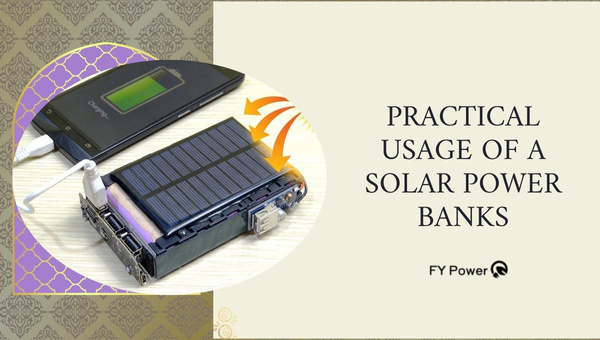I’ve often found myself intrigued by the advancements in solar technology. In particular, the invention of the solar power bank piqued my interest. These compact devices claim to harness sunlight and convert it into electrical energy we can use to power our indispensable gadgets.
But can you also imagine this – a sunny day at your disposal, your phone in desperate need of a charge, and no socket in sight? Who’d come to your rescue, if not a solar power bank?
Solitary outdoor ventures or unforeseen electricity shuffles, nothing could ever stop you from staying connected if you possess one essential gadget – A Solar Power Bank!
It’s a fabulous innovation undoubtedly, allowing us to harness natural sunlight and transform it into reusable energy anywhere under the sky. Irrespective of where you are or what time it is, with adequate sunlight, these robust companions will recharge your devices without a hitch.
Understanding, How a Solar Power Bank Works?
To understand how a solar power bank works, we must first take a look at the science behind it and then explore the thoughtful design that puts this science to use.
The Science behind Solar Energy
Solar energy is a resource of power that I find fascinating. It’s clean, inexhaustible, and free to use. But how exactly does it work? Well, thanks to something called photovoltaic cells, sunlight can be converted into usable electricity.
These photovoltaic cells are made of semiconductor material, usually silicon. When sunlight shines on these cells, photons (light particles) are absorbed by the semiconductor material. This process excites electrons in the cell and creates an electric field across layers. Because of this electric field process, electrons are pushed out of the silicon junction creating an electrical current.
So basically these photovoltaic cells in solar power accessories such as solar generators capture rays from the sun and convert them into electrical energy which you can use to power your devices.
The Design of a Solar Power Bank
The sleek designs that most solar power banks come with may look simple at first glance but there is quite some intricate engineering involved.
The main components inside a solar power bank include:
1) Solar Panels: They house those all-important photovoltaic cells we’ve just talked about which convert sunlight into electricity.
2) Battery: This is where all that handy converted solar energy gets stored for later use.
3) Charge Regulator: This little device controls how much current goes from the solar panels to the battery. This prevents your battery from overcharging which can cause damage or worse — make it explode!
4) Inverter: Once the battery stores enough power, it’s time to charge your gadgets. But before that happens, that stored energy needs to be converted back into a usable format by the inverter.
5) Outputs: These are the USB ports (or other types of ports, depending on the model) where you plug your device cables into.
Also read: DIY Portable Solar Panel Stand: An Easy Guide
Solar Power Bank Effectiveness
Now we come to the important question: How effective are these portable solar chargers, really?
The technology behind a solar power bank revolves around its ability to convert sunlight into electricity. This process, known as photovoltaic energy conversion, is essentially what determines the effectiveness of your portable charger.
When it comes to solar power bank effectiveness, there are several factors at play – the amount and intensity of sunlight available, internal circuitry design, the quality of photovoltaic cells used, and technical limitations such as heat tolerance.
In perfect conditions with direct sunlight available – say, on a clear sunny day at the beach or up a mountain – your power bank can indeed absorb enough sun rays for charging your devices. However, inside homes or on cloudy days where natural light isn’t as abundant—it’s not that efficient.
That’s not to say they don’t work indoors or in less-than-ideal weather situations! They merely take longer due to lowered capacity caused by less intense light.
So yes, while not perfect all-round performers like their conventional counterparts which guarantee consistent charging speed regardless of external conditions—a solar power bank provides ample backup during outdoor activities or emergencies while contributing towards reducing our carbon footprint.
Also Read: Which generator is required to run a refrigerator?
Factors Affecting a Solar Power Bank’s Functioning
How well a solar power bank works largely depends on certain circumstances and external factors. These variables not only impact the charging speed and overall capacity of the solar power bank, but they also contribute to its effectiveness and durability.
Two significant influencers I relate to the functioning of a solar power bank are sunlight intensity and temperature or weather conditions.
Sunlight Intensity
The first aspect I want to touch upon is sunlight intensity. Solar power banks, like other solar-powered devices, rely mainly on sunlight for energy collection. Therefore, the amount of sunlight hitting the panels directly affects their efficiency.
In environments with high-intensity sunlight (such as clear sky days), my experience tells me that a solar power bank will charge faster due to increased exposure to direct sunlight. This condition ultimately boosts solar power bank effectiveness because it’s able to extract more energy from its primary source – thanks sun!
However, don’t expect your solar device to perform up-to-top during early mornings or late afternoons where sunshine is weaker than midday hours of equal intensity.
Temperature & Weather Conditions
Another player affecting portable solar charger efficiency is weather conditions – particularly temperature. Believe it or not but hot isn’t always better for these gadgets!
Of course, sunny days provide ample light needed for charging however exceedingly high temperatures may negatively impact your device’s performance by overheating its circuits causing inefficiency in the energy conversion process which may also reduce lifespan over time.
Conversely, solar power banks aren’t a fan of cold weather either. When temperatures drop below freezing point, battery capacity often diminishes significantly. Frosty conditions can directly affect their solar charging speed, leading to prolonged charging times or insufficient power to feed your devices.
But don’t get me wrong – overcast skies or rainy days aren’t total spoilers for your solar-powered dreams either! Even under these less favorable conditions, a good-quality solar power bank can still accumulate some energy – although at a slower rate compared to bright sunny days.
Also Read: Who Makes Champion Generators & Where Are They Made?
Practical Usage Of A Solar Power Bank
I have discovered that solar power banks are a fantastic tool, especially when I’ve found myself in situations where access to an electricity grid was either not possible or too inconvenient. So, let me share a few scenarios where I found these devices to be incredibly beneficial.

Camping and Trekking
With the increasing call to get closer to nature and reduce our environmental impact, many of us might enjoy camping and trekking – two activities that often lead us off the beaten path away from reliable power sources. This is where a solar power bank shows its worth.
When I am pitched up under the stars with just my backpack as a company, a solar generator tucked into one of the pockets offers peace of mind. I can use it to charge my smartphone or digital camera without needing an outlet. Plus, it always comes in handy for overnight camps since we all know how quickly phone batteries drain when trying to capture those perfect moments.
Rural Area Usage
If you’ve ever been to rural areas where electricity isn’t always guaranteed or reliable, you’d understand what a difference solar power banks could make. For instance, during my travels through rural areas in Asia and Africa, electricity is seen as a commodity rather than a guaranteed right.
On several occasions, my solar power bank served as my primary source of energy—allowing me to recharge basic devices such as phones and flashlights. This has often saved me from numerous inconveniences while providing an effective solution against intermittent blackouts – underscoring its capacity.
Disaster Preparedness
No one likes to think about disasters, but it’s always good to be prepared. Natural factors such as hurricanes and earthquakes can disrupt power supply for several days, rendering electric appliances useless. On those rare unfortunate occasions when I’ve found myself dealing with power outages, my solar power bank has been an absolute lifesaver.
These devices are not just portable but durable too. By harnessing sunlight during the day, I could charge my devices at night—helping me remain connected despite the dire circumstances. So for anyone keen on developing a disaster kit, a solar power bank should definitely be included on the list.
Also Read: Predator Engines Oil Type and Capacity Guide
FAQs
How long does it take for a solar power bank to charge fully?
The charging speed of a solar power bank can vary based on its capacity and the power of the sunlight. However, in full direct sunlight, it may take approximately between 25-30 hours. If your power bank has a large capacity, it may require more time.
Can a solar power bank be charged indoors or on cloudy days?
Yes, you can charge your solar power bank indoors or during cloudy days. However, its effectiveness might decrease since the strength of UV rays is much less indoors and during overcast conditions. To increase portable solar charger efficiency, make sure it’s exposed to direct sunlight.
How durable are solar power banks?
The durability of a solar power bank primarily depends on the materials used in its construction. High-quality solar chargers are built with weather-resistant materials that can withstand harsh environmental conditions and rough handling, making them highly durable.
Conclusion
By and large, I’ve found that a solar power bank can indeed be an effective, efficient, portable, and durable solution for keeping my devices charged.
Its environmental impact is also something that can truly help make a difference. While its charging speed and capacity may differ based on the model, a solar power bank certainly can do what it promises.
Key Takeaway Points
- Solar power banks are effective in their function.
- They provide efficiency with charging speed varying depending on models.
- The portability of these power banks is one of their biggest assets.
- Durability is another factor that sets them apart.
- Opting for a solar power bank contributes positively to environmental sustainability.

